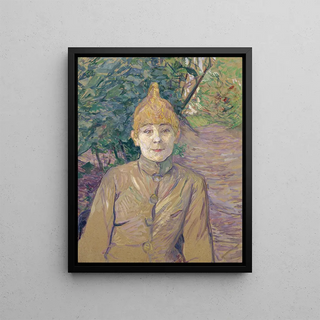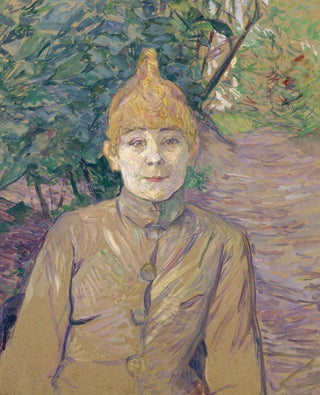Art print | The prostitute - Henri de Toulouse-Lautrec


View from behind

Frame (optional)
In the vibrant universe of the late 19th century, one artwork stands out for its boldness and its ability to capture the essence of a rapidly changing era. "The Prostitute - Henri de Toulouse-Lautrec" is much more than a simple depiction of a female figure; it is a mirror of Parisian society, a reflection of the pleasures and sufferings that coexist in the world of cabarets and brothels. Through this piece, Toulouse-Lautrec immerses us in a raw reality, while maintaining an artistic sensitivity that transcends the subject. Beauty and melancholy intertwine in this painting, inviting us to explore the depths of the human soul.
Style and uniqueness of the artwork
Toulouse-Lautrec's style is immediately recognizable, characterized by bold lines and vibrant colors that evoke the lights of Montmartre. In "The Prostitute," the artist uses a palette of warm tones to emphasize the sensuality of the subject, while incorporating compositional elements that create tension between intimacy and exposure. The central figure, both vulnerable and provocative, is placed in a space that feels both welcoming and oppressive. The meticulous details of clothing and accessories add a dimension of realism, while the blurred background suggests a world in motion, constantly evolving. This artwork does not merely depict a woman; it tells a story, that of a universe where beauty and decay are intertwined.
The artist and his influence
Henri de Toulouse-Lautrec, an emblematic figure of the post-impressionist movement, captured the spirit of his time with rare acuity. His life, marked by personal challenges and struggles against isolation, profoundly influenced his art. By mingling with artists, dancers, and prostitutes of his era, he developed a unique perspective on Parisian society. His work is a poignant testimony of nightlife, a celebration of margins and the invisible. Toulouse-Lautrec not only redefined the representation of women in art but also paved the way for a new understanding of beauty.

Matte finish

View from behind

Frame (optional)
In the vibrant universe of the late 19th century, one artwork stands out for its boldness and its ability to capture the essence of a rapidly changing era. "The Prostitute - Henri de Toulouse-Lautrec" is much more than a simple depiction of a female figure; it is a mirror of Parisian society, a reflection of the pleasures and sufferings that coexist in the world of cabarets and brothels. Through this piece, Toulouse-Lautrec immerses us in a raw reality, while maintaining an artistic sensitivity that transcends the subject. Beauty and melancholy intertwine in this painting, inviting us to explore the depths of the human soul.
Style and uniqueness of the artwork
Toulouse-Lautrec's style is immediately recognizable, characterized by bold lines and vibrant colors that evoke the lights of Montmartre. In "The Prostitute," the artist uses a palette of warm tones to emphasize the sensuality of the subject, while incorporating compositional elements that create tension between intimacy and exposure. The central figure, both vulnerable and provocative, is placed in a space that feels both welcoming and oppressive. The meticulous details of clothing and accessories add a dimension of realism, while the blurred background suggests a world in motion, constantly evolving. This artwork does not merely depict a woman; it tells a story, that of a universe where beauty and decay are intertwined.
The artist and his influence
Henri de Toulouse-Lautrec, an emblematic figure of the post-impressionist movement, captured the spirit of his time with rare acuity. His life, marked by personal challenges and struggles against isolation, profoundly influenced his art. By mingling with artists, dancers, and prostitutes of his era, he developed a unique perspective on Parisian society. His work is a poignant testimony of nightlife, a celebration of margins and the invisible. Toulouse-Lautrec not only redefined the representation of women in art but also paved the way for a new understanding of beauty.






